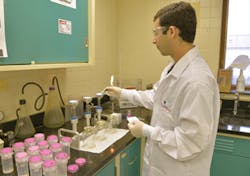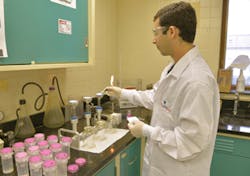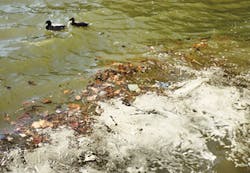Contaminants of Concern: Regulatory and Treatment Considerations in Industrial Manufacturing Processes
By Art Haddaway, WaterWorld Editor
A number of contaminants of emerging concern (CEC) have been associated with wastewater from industrial manufacturing sites and processes. Whether it's polluted effluent from mining practices, oil and gas production, power generation, or food and beverage operations to name a few, chemicals are often discharged into surrounding lakes, rivers and oceans and can contribute to a variety of ongoing challenges relating to water quality and conservation.
According to recent statistics, more than half the volume of all U.S. water pollution, including the most harmful contaminants, stems from industrial applications. These impurities can permeate groundwater, pollute local water sources and contaminate drinking water, and can thus pose a significant threat to public health and the environment. As such, preventing these CECs and meeting new and emerging water quality regulations in the process is critical.
Given the vast number, causes and complexities of these contaminants, it's vital that industry professionals understand what's involved in best managing them. With that, some key components can include identifying:
- the type of toxins
- where they originated and where they're primarily found
- what level of impact they have on water resources and public health
- how to best regulate them
- what kinds of treatment are most applicable and effective
"With 85,000 registered chemicals in the U.S. EPA toxic substance
inventory -- and new compounds being added every day -- it is imperative that water utilities stay abreast of issues related to emerging contaminants so that appropriate treatment decisions can be made," said Mark LeChevallier, director of Innovation & Environmental Stewardship for American Water.
He suggested that to do that, utilities can become informed on issues of specific importance to them by attending local, regional or national conferences; staying in contact with experts in emerging issues and maintaining contacts with local universities; participating in research projects by providing operational information and collecting samples; and developing an in-house research program to study contaminants of high concern.
Examples of prominent industrial pollutants include perchlorate, nitrosamines, hexavalent chromium (hex chrome), selenium, algal toxins, legionella, pharmaceuticals and personal care products (PPCP), and nutrients such as nitrogen and phosphorus (N&P). These contaminants can comprise a variety of potentially hazardous compounds such as grit, sulfuric elements, leads and metals, sodium composites, oils, phosphates and nitrates, solvents, petrochemicals, and more.
Many of these impurities, along with several others stemming from manufacturing processes, often share similar attributes, but it can also be difficult to distinguish their presence, source of origin or frequency of occurrence given that they may be impacted by time, by the adoption of new treatment technologies or equipment, or by regional or environmental influences. In addition, measuring the risk to human health and the environment can also be problematic since it is directly associated with understanding these characteristics.
According to the Environmental Protection Agency (EPA), particular "chemicals are being discovered in water that previously had not been detected or are being detected at levels that may be significantly different than expected." LeChevallier added, "That's the challenge with some of these CECs: if you can find their occurrence nationally or regionally and see their levels and frequency but can't put it in context with some health levels, it's hard to understand the magnitude of the problem."
Regulations
Along with current programs, such as the Clean Water Act (CWA), Safe Drinking Water Act (SDWA) and National Pollutant Discharge Elimination System (NPDES) for example, the EPA and other water and environmental authorities are continuing to evaluate more robust drinking water standards, or maximum contaminant levels (MCLs), as well as more comprehensive Total Maximum Daily Loads (TMDLs), Effluent Limitations Guidelines and source water protections to help better monitor, decrease and ultimately eliminate these impurities.
Under the CWA, the EPA issues a variety of effluent guidelines for new and existing sources of pollution that are more technology-based rather than concentrated on risk or impact on receiving waters, an EPA spokesperson said. Whereas under the SDWA, the EPA's Contaminant Candidate List (CCL) and Unregulated Contaminants Monitoring Rule (UCMR) allow the Agency to oversee a number of impurities that states observe in their drinking water supplies through monitoring programs, as well as determine appropriate regulations. Every five years, the EPA releases these reports. Currently, the CCL3 includes 104 chemicals or chemical groups and 12 microbiological contaminants, and the UCMR3 comprises 30 contaminants (28 chemicals and two viruses).
With nitrosamine for example, N-nitrosodimethylamine (NDMA) is the most commonly-detected form found in surface waters and is derived from cosmetics, pesticides and rubber manufacturing, usually when chlorine unstably reacts with polymers. NDMA is included in the CCL3 and was listed in the UCMR2, and the EPA is currently continuing to evaluate a more robust drinking water standard, or MCL, for the chemical.
As for perchlorate, a chemical used in the production of rocket fuels, propellants and explosives, the EPA has ultimately enforced regulation under the SDWA and is seeking to enact a national primary drinking water regulation (NPDWR) as well. Some states however -- such as California, which has an MCL of 6 ppb, and Massachusetts, which has an MCL of 2 ppb -- already regulate perchlorate in drinking water. The Agency is continuing to evaluate the science on its health effects and exposure as well as laboratory methods and treatment technologies necessary for measuring and removing the pollutant in drinking water, said an EPA spokesperson. Some states however, already regulate perchlorate in drinking water.
Another common CEC is selenium, a metal found in natural deposits such as ores containing other elements but also in rubber, textile and petroleum manufacturing, to name a few. The EPA has regulated the compound under the Phase II Rule and has determined that the MCLs and maximum contaminant level goals (MCLGs) established as part of the Six Year Review are still effective. The Agency indicated that individual states may set more stringent standards for selenium depending on site-specific conditions. The EPA has also proposed revised technology-based effluent regulations for the Steam Electric Power Generating category (40 CFR Part 423). The new rule aims to better control and strengthen primary waste streams at approximately 1,100 steam power plants across the U.S. to minimize wastewater discharges.
Hexavalent chromium, or chromium-6, derived from manufacturing processes such as welding and metal plating, is also monitored under the UCMR3, but no federal drinking water standard currently exists. An EPA spokesperson said that prior to determining whether or not the chromium drinking water regulation will be revised, the Agency must issue its final human health assessment for the chemical. In California however, an MCL regulations package of 10 ppb was recently approved and becomes effective on July 1, 2014.
The EPA has also developed the Recommended Elements of a State Framework for Managing Nitrogen and Phosphorus Removal to better regulate and reduce the presence of N&P in the nation's waters. The framework focuses on ensuring "effectiveness of point source permits in targeted/priority sub-watersheds for municipal and industrial wastewater treatment facilities that contribute to significant measureable N&P loadings," according to an EPA spokesperson.
Treatment
Certain on-site control efforts can be considered to better treat and prevent these contaminants and more efficiently reduce their influence on public and environmental health. Traditional techniques for example, such as end-of-pipe treatment methods, have continued to remain effective throughout the years, and "it's generally easier or more cost-effective for public health and protection to treat [impurities] at the source than allowing industrial streams to contaminate the water and having to treat it downstream," said LeChevallier.
This route however, while sufficient, focuses on treating these impurities rather than preventing them as a whole. Therefore, pollution prevention, as practiced by the Michigan Source Reduction Initiative (MSRI) for instance, is a viable solution. Launched in the fall of 1996 by a joint effort among the Dow Chemical Company, the Natural Resources Defense Council (NRDC), local and regional environmental groups, and residents of Midland, Mich., the MSRI project sought to reduce discharges of 26 leading chemicals at Dow's Midland facility by 35 percent by April 30, 1999, using only pollution prevention, according to an NRDC report.
Pollution prevention concentrates on increasing operational efficiencies and decreasing reliance on untreated chemicals, often while cutting extra costs, the report mentioned. "Rather than relying on end-of-the-pipe devices, such as incinerators or wastewater treatment plants, it requires process improvements at facilities that will decrease waste at the source before it is generated," it said. The NRDC, for example, proposed new environmentally-friendly methods at the Dow plant such as producing reactions at a lower temperature by integrating cooling equipment at the affected area, as well as using cleaner solvents and reactants, and even reusing those already in service.
Convened and facilitated by the Meridian Institute, "over only a two-year time frame, the [MSRI] project found opportunities to reduce nearly 7 million pounds of wastes and emissions at the site while saving the company over $5 million annually," according to the NRDC report. Further, "It reduced targeted emissions by 43 percent, from 1 million to 593,000 pounds, and targeted wastes by 37 percent, from 17.5 million to 11 million pounds." Even more, an important goal of the project was to "foster broader institutional changes within Dow that would further shift the company's thinking from traditional environmental compliance to pollution prevention and further integrate health and environmental concerns into core business decision making."
Utilities and organizations can also conduct a variety of collaborative field and lab surveys to measure CECs and address particular gaps in data. They can establish workshops, meetings and expert advisory panels to build scientific consensus to offer further insight into these contaminants. Another option is to adopt established and emerging biological techniques that offer a more holistic treatment approach that encompasses a broader range of chemicals.
These innovative methods can encompass air diffusion, mechanical aeration, trickling filtration, aerobic and anaerobic options, activated sludge, advanced oxidation, and water quality screening, to name a few. Other more emerging techniques can include bioaugmentation, membrane biofilm reactors, nitritation/denitritation, and deammonification. "The industry has moved toward biological treatment as a way toward sustainability -- removing a whole variety of different contaminants or precursors to contaminants," said LeChevallier. Unlike traditional treatment methods, a biological approach as a whole converts complex toxic chemicals into simpler substances and improves treatment by allowing certain microorganisms to feed on them.
As enacted by the Southern California Coastal Water Research Project (SCCWRP) for example, conducting field surveys, building scientific consensus and developing biological methods -- like rapid water quality screening -- can provide additional advantages to thwarting known or unknown toxins. Established in 1969, the SCCWRP is a research institute focusing on the well-being of coastal ecosystems of Southern California. The organization's website indicated that its investigations are classified based on pollutants' "origin, use and environmental fate, as well as their potential for reproductive effects and/or endocrine disruption."
Conclusion
A SCCWRP fact sheet revealed that currently over 100,000 chemicals are prevalent but fewer than 130 constituents are regulated as priority pollutants. Ultimately, LeChevallier said that effective regulations and treatment options can be best determined based on whether those methods create an "opportunity for meaningful public health risk reduction." An EPA spokesperson further revealed that the Agency "develops its priorities for addressing water pollution through scientific evidence driven by regulatory processes; issues of priority presented to the Agency by states, municipalities and other federal agencies; and overarching widespread water pollution issues."
"When it comes to industrial CECs, the EPA and drinking water community are continuing to work to determine if any of them need to be regulated in drinking water or if there are other control options," said Alan Roberson, director of federal relations at the American Water Works Association. "Clearly, keeping these emerging CECs out of drinking water supplies is the preferred option as compared to installing additional treatment for their removal."
LeChevallier added, "There are several contaminants we're doing research on, and we're looking at these emerging issues so that we better understand the situation and better work with EPA. If in the future there are regulations that are developed around them, we will have a good idea of their magnitude and what some of the cost and treatment options might be so we can make good decisions on how to best serve our customers."
Archived IWW Issues
About the Author

Art Haddaway
Assistant Editor
Art Haddaway is the Assistant Editor of WaterWorld and Industrial WaterWorld magazines. A writer and editor of over 10 years, he has contributed to a variety of regional publications covering everything from current events to creative features. Art is a graduate of Oral Roberts University in Tulsa, Okla., with a bachelor’s degree in print journalism.



